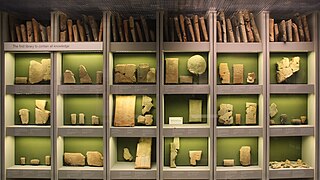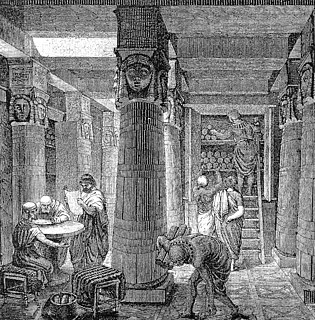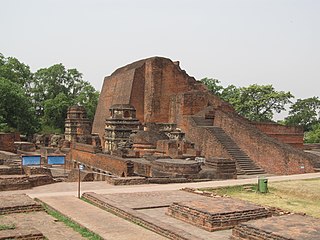 W
WThe Royal Library of Antioch was commissioned by Antiochus III of the Seleucid Empire around 221 B.C. in Ancient Syria and opened to scholars. Euphorion of Chalcis, an intellectually influential ancient poet from Greece, accepted the challenge issued by the king and established the royal library at Antioch. He also served as principal librarian until his death. The library, along with the city itself, was considered by some to be the cultural capital of the ancient world, even more prestigious than Pergamon.
 W
WThe Royal Library of Ashurbanipal, named after Ashurbanipal, the last great king of the Assyrian Empire, is a collection of more than 30,000 clay tablets and fragments containing texts of all kinds from the 7th century BC, including texts in various languages. Among its holdings was the famous Epic of Gilgamesh.
 W
WThe Friends of Herculaneum Society is a British association founded in 2004 to promote research into the archaeological site of Herculaneum at Ercolano, near Naples, Italy. Its headquarters are in the Ioannou Centre for Classical and Byzantine Studies in Oxford. It is registered as a charity and incorporated as a company under the name "The Herculaneum Society."
 W
WHadrian's Library was created by Roman Emperor Hadrian in AD 132 on the north side of the Acropolis of Athens.
 W
WThe Great Library of Alexandria in Alexandria, Egypt, was one of the largest and most significant libraries of the ancient world. The Library was part of a larger research institution called the Mouseion, which was dedicated to the Muses, the nine goddesses of the arts. The idea of a universal library in Alexandria may have been proposed by Demetrius of Phalerum, an exiled Athenian statesman living in Alexandria, to Ptolemy I Soter, who may have established plans for the Library, but the Library itself was probably not built until the reign of his son Ptolemy II Philadelphus. The Library quickly acquired many papyrus scrolls, due largely to the Ptolemaic kings' aggressive and well-funded policies for procuring texts. It is unknown precisely how many such scrolls were housed at any given time, but estimates range from 40,000 to 400,000 at its height.
 W
WThe Library of Celsus is an ancient Roman building in Ephesus, Anatolia, now part of Selçuk, Turkey. The building was commissioned in the 110s A.D. by a consul, Gaius Julius Aquila, as a funerary monument for his father, former proconsul of Asia Tiberius Julius Celsus Polemaeanus, and completed during the reign of Hadrian, sometime after Aquila's death. The library is considered an architectural marvel, and is one of the only remaining examples of a library from the Roman Empire. The Library of Celsus was the third-largest library in the Roman world behind only Alexandria and Pergamum, believed to have held around twelve thousand scrolls. Celsus is buried in a crypt beneath the library in a decorated marble sarcophagus. The interior measured roughly 180 square metres.
 W
WThe Library of Pergamum in Pergamum, Turkey, was one of the most important libraries in the ancient world.
 W
WThe library of Philippopolis is one of the administrative buildings built in the Northern part of the Roman forum in Plovdiv. The rectangular-shaped building has an approximate width of 20m and length of 15m. The library's main purpose was storing manuscripts and scrolls but it was also used as a place for education, reading, public discussions and speeches. Philippopolis was among the few ancient towns which had a library.
 W
WThe Lyceum was a temple dedicated to Apollo Lyceus.
 W
WManí is a small city in Maní Municipality in the central region of the Yucatán Peninsula, in the Mexican state of Yucatán. It is about 100 km to the south south-east of Mérida, Yucatán, some 16 km east of Ticul. The village of Tipikal lies 6 km to the east.
 W
WNalanda was a renowned Buddhist monastery and university in ancient Magadha, India. Located near the city of Rajagriha and about 90 kilometres (56 mi) southeast of Pataliputra, it operated from about 427 to 1197 CE. Nalanda was established during the Gupta Empire era, and was supported by numerous Indian and a few Javanese patrons – both Buddhists and non-Buddhists. Over some 750 years, its faculty included some of the most revered scholars of Mahayana Buddhism. Nalanda Mahavihara taught six major Buddhist schools and philosophies such as Yogacara and Sarvastivada, the Hindu Vedas and its six philosophies, as well as subjects such as grammar, medicine, logic and mathematics. The university was also a major source of the 657 Sanskrit texts carried by pilgrim Xuanzang and the 400 Sanskrit texts carried by Yijing to China in the 7th-century, which influenced East Asian Buddhism. It was sacked and destroyed by the troops of Muhammad bin Bakhtiyar Khalji, partly restored thereafter, and continued to exist till about 1400 CE. Today, it is a UNESCO World Heritage Site.
 W
WNysa on the Maeander was an ancient city and bishopric of Asia Minor, whose remains are in the Sultanhisar district of Aydın Province of Turkey, 50 kilometres (31 mi) east of the Ionian city of Ephesus, and which remains a Latin Catholic titular see.
 W
WRaglan Library was a library located in Raglan Castle in the county of Monmouthshire in south east Wales.
 W
WSakya Monastery, also known as Pel Sakya is a Buddhist monastery situated 25 km southeast of a bridge which is about 127 km west of Shigatse on the road to Tingri in Tibet Autonomous Region.
 W
WSarouyeh was a large library in ancient pre-Islamic Iran. The 10th century chronicler Ahmad ibn Rustah refers to it as "Sarough" (ساروق). The Fars Nameh of Ibn Balkhi calls it Haft Halkeh.
 W
WThe Serapeum of Alexandria in the Ptolemaic Kingdom was an ancient Greek temple built by Ptolemy III Euergetes and dedicated to Serapis, who was made the protector of Alexandria. There are also signs of Harpocrates. It has been referred to as the daughter of the Library of Alexandria. The site has been heavily plundered.
 W
WThe Theological Library of Caesarea Maritima, or simply the Library of Caesarea, was the library of the Christians of Caesarea Maritima in Palestine in ancient times.
 W
WTimgad was a Roman city in the Aurès Mountains of Algeria. It was founded by the Roman Emperor Trajan around CE 100. The full name of the city was Colonia Marciana Ulpia Traiana Thamugadi. Emperor Trajan named the city in commemoration of his mother Marcia, eldest sister Ulpia Marciana, and father Marcus Ulpius Traianus.
 W
WThe Bibliotheca Ulpia was a Roman library founded by the Emperor Trajan in AD 114 in his forum, the Forum of Trajan, located in ancient Rome. It was considered one of the most prominent and famous libraries of antiquity and became the major library in the Western World upon the destruction of the Library of Alexandria in the 3rd century. It was the only Roman library to survive until the Fall of Rome in the mid-fifth century.
 W
WThe Villa of the Papyri was an ancient Roman villa in Herculaneum, in what is now Ercolano, southern Italy. It is named after its unique library of papyri, discovered in 1750. The Villa was considered to be one of the most luxurious houses in all of Herculaneum and in the Roman world. Its luxury is shown by its exquisite architecture and by the very large number of outstanding works of art discovered, including frescoes, bronzes and marble sculpture which constitute the largest collection of Greek and Roman sculptures ever discovered in a single context.